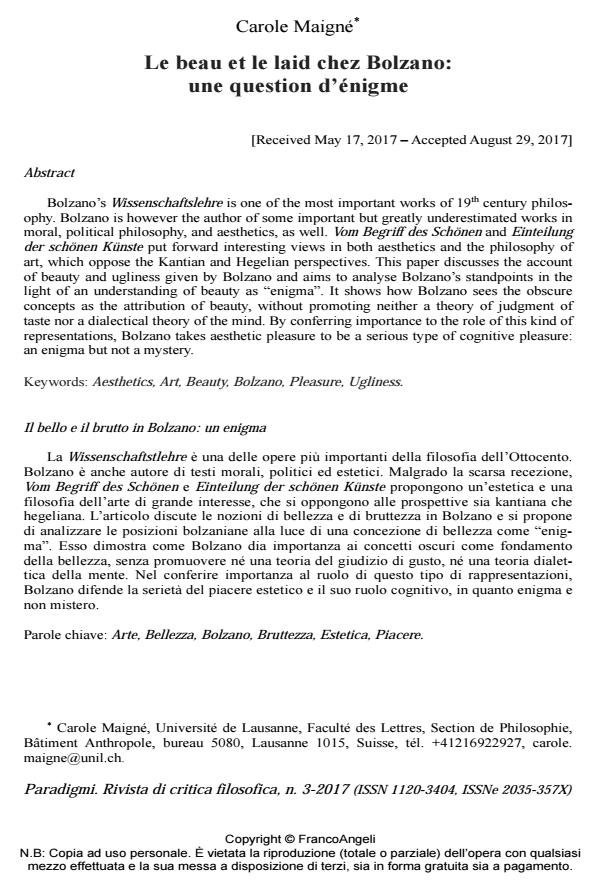Le beau et le laid chez Bolzano: une question d’énigme
Titolo Rivista PARADIGMI
Autori/Curatori Carole Maigné
Anno di pubblicazione 2017 Fascicolo 2017/3 Lingua Francese
Numero pagine 15 P. 25-39 Dimensione file 187 KB
DOI 10.3280/PARA2017-003003
Il DOI è il codice a barre della proprietà intellettuale: per saperne di più
clicca qui
Qui sotto puoi vedere in anteprima la prima pagina di questo articolo.
Se questo articolo ti interessa, lo puoi acquistare (e scaricare in formato pdf) seguendo le facili indicazioni per acquistare il download credit. Acquista Download Credits per scaricare questo Articolo in formato PDF

FrancoAngeli è membro della Publishers International Linking Association, Inc (PILA)associazione indipendente e non profit per facilitare (attraverso i servizi tecnologici implementati da CrossRef.org) l’accesso degli studiosi ai contenuti digitali nelle pubblicazioni professionali e scientifiche
Bolzano’s Wissenschaftslehre is one of the most important works of 19th century philos-ophy. Bolzano is however the author of some important but greatly underestimated works in moral, political philosophy, and aesthetics, as well. Vom Begriff des Schönen and Einteilung der schönen Künste put forward interesting views in both aesthetics and the philosophy of art, which oppose the Kantian and Hegelian perspectives. This paper discusses the account of beauty and ugliness given by Bolzano and aims to analyse Bolzano’s standpoints in the light of an understanding of beauty as "enigma". It shows how Bolzano sees the obscure concepts as the attribution of beauty, without promoting neither a theory of judgment of taste nor a dialectical theory of the mind. By conferring importance to the role of this kind of representations, Bolzano takes aesthetic pleasure to be a serious type of cognitive pleasure: an enigma but not a mystery.
La Wissenschaftstlehre è una delle opere più importanti della filosofia dell’Ottocento. Bolzano è anche autore di testi morali, politici ed estetici. Malgrado la scarsa recezione, Vom Begriff des Schönen e Einteilung der schönen Künste propongono un’estetica e una filosofia dell’arte di grande interesse, che si oppongono alle prospettive sia kantiana che hegeliana. L’articolo discute le nozioni di bellezza e di bruttezza in Bolzano e si propone di analizzare le posizioni bolzaniane alla luce di una concezione di bellezza come "enigma". Esso dimostra come Bolzano dia importanza ai concetti oscuri come fondamento della bellezza, senza promuovere né una teoria del giudizio di gusto, né una teoria dialettica della mente. Nel conferire importanza al ruolo di questo tipo di rappresentazioni, Bolzano difende la serietà del piacere estetico e il suo ruolo cognitivo, in quanto enigma e non mistero.
Keywords:Arte, Bellezza, Bolzano, Bruttezza, Estetica, Piacere.
- Bergmann H. (1909). Das philosophische Werk B. Bolzanos mit Benutzung ungedruckter Quelle kritisch untersucht. Halle: Max Niemeyer.
- Blaukopf K (1996). Die Ästhetik B. Bolzanos. Sankt Augustin: Academia.
- Bolzano B. (1810). Contributions à une exposition mieux fondée des mathématiques. In: Premiers écrits, trad. franç. de C. Maigné et Jan Sebestik. Paris: Vrin, 2010: 73-180.
- Bolzano B. (1818). Über den Begriff des Lächerlichen. In: Bergmann H. (1909): 122-124.
- Bolzano B. (1843). Du concept du beau. In: Écrits esthétiques, trad. franç. de C. Maigné, N. Rialland., J. Sebestik, Paris: Vrin, 2017: 49-150.
- Bolzano B. (1849). De la division des beaux-arts. In: Écrits esthétiques, trad. franç. de C. Maigné, N. Rialland, J. Sebestik. Paris: Vrin, 2017: 151-204.
- Livingston P. (2014). Bolzano on Beauty. British Journal of Aesthetics, 54, 3: 269-284,
- Livingston P. (2015). An Introduction to Bolzano’s Essay on Beautiful. Estetika. The Central European Journal of Aesthetics, LII/VIII, 2: 203-228.
- Maigné C. (2015). L’esthétique autrichienne de l’école herbartienne. Austriaca, 78: 29-46.
- Maigné C. (2017). L’exigence de clarté: les Écrits esthétiques de Bernard Bolzano. In: Bolzano B. Écrits esthétiques, trad. franç. de C. Maigné, N. Rialland, J. Sebestik. Paris: Vrin: 7-46.
- McCormick P. (1991). Bolzano and the Dark Doctrine. An Essay in Aesthetics. In: Smith B., ed. Structure and Gestalt. Philosophy and Literature in Austria-Hungary and her Successor States. Amsterdam: John Benjamins Publishing Company: 69-111.
- Morscher E. (2008). Bernard Bolzano’s Life and Work. Sankt Augustin: Academia.
- Neumaier O. (1999). Die Kunst des bloßen Gedankens. In: Morscher E., Hrsg. Bernard Bolzanos geistiger Erbe für das 21. Jahrhundert. Sankt Augustin: Academia: 411-434.
- Pop A. (2015). Introduction to Rosenkranz K., Aesthetics of Ugliness: A Critical Edition. Ed. and transl. by A. Pop and M. Widrich. London-Oxford: Blooms-bury Academic.
- Rosenkranz K. (1853). Esthétique du laid, trad. franç. par S. Muller, Présentation G. Raulet. Paris: Circé, 2004.
- Sebestik J. (1992). Logique et mathématique chez Bernard Bolzano. Paris: Vrin.
- Vesper A. (2012). Contempler, distinguer. Bolzano sur la conceptualité de la perception esthétique. In: Morel Ch., éd. Esthétique et logique, de Leibniz aux contemporains. Villeneuve d’Ascq: Presses du Septentrion.
- Winter E (1956). Der böhmische Vormärz, in Briefen Bolzanos an Prihonsky 1824-1848. Berlin: Akademie Verlag.
- Winter E (1965). Wissenschaft und Religion im Vormärz, Der Briefwechsel Bernard Bolzanos mit Michael Josef Fesl 1822-1848. Berlin: Akademie Verlag
Carole Maigné, Le beau et le laid chez Bolzano: une question d’énigme in "PARADIGMI" 3/2017, pp 25-39, DOI: 10.3280/PARA2017-003003